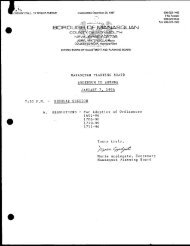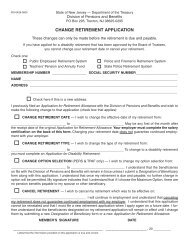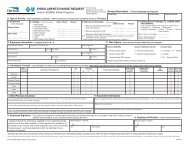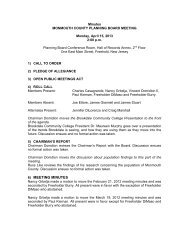NATURAL and CULTURAL FEATURES of MONMOUTH COUNTY
NATURAL and CULTURAL FEATURES of MONMOUTH COUNTY
NATURAL and CULTURAL FEATURES of MONMOUTH COUNTY
You also want an ePaper? Increase the reach of your titles
YUMPU automatically turns print PDFs into web optimized ePapers that Google loves.
chance <strong>of</strong> a named storm making l<strong>and</strong>fall in the vicinity <strong>of</strong> the County (URS, 2008). Recent<br />
Federal Disaster Declarations occurred in coastal NJ after storms in 1991, 1992 <strong>and</strong> 1998<br />
(Farrell, 2007).<br />
Hurricanes in the northern hemisphere rotate west to east (counterclockwise/cyclonic) but move<br />
through the ocean from east to west. Most Atlantic hurricanes form when the ocean is at least 80<br />
degrees F <strong>of</strong>f the west coast <strong>of</strong> Africa, where the desert air <strong>of</strong> the Sahara rises to meet the cool air<br />
drifting west over the mountains; periods <strong>of</strong> heavy rainfall in West Africa appear to be related to<br />
an increased frequency in Atlantic hurricanes (deVilliers, 2006; Howstuffworks, 2006; Coch,<br />
1999). These converging equatorial winds collide near the surface <strong>and</strong> push warm, moist air<br />
upward where it is held together at higher altitudes by strong but uniform-speed winds. The<br />
rising warm air can then continuously cool <strong>and</strong> release water <strong>and</strong> heat (the “latent heat <strong>of</strong><br />
condensation”) - <strong>and</strong> build into a hurricane (Howstuffworks, 2006). The eye <strong>of</strong> a hurricane is<br />
always a low pressure area, <strong>and</strong> the right eye wall in the northern hemisphere has the fastest,<br />
most violent winds because the wind speed <strong>and</strong> the hurricane speed <strong>of</strong> motion are in sync<br />
(Howstuffworks, 2006). In fact, while the occurrence <strong>of</strong> a hurricane greater than a Category 3 in<br />
the northeast is remote, the right eye wall under certain conditions can have the destructive<br />
potential <strong>of</strong> a Cat 4 or 5 storm (Coch, 1995). The position <strong>of</strong> the right eye wall as it moves over<br />
populated l<strong>and</strong> areas is what makes a “coast normal” hurricane the most destructive (Coch, 1999)<br />
Hurricanes are accelerated by westerly weather systems as they move north <strong>of</strong> Cape Hatteras;<br />
hurricanes in the northeast move 2-3 times faster than in the southeastern US - westerlies can<br />
move a storm from South Carolina to Newfoundl<strong>and</strong> in 24 hours (Coch, 1995; deVilliers, 2006).<br />
All <strong>of</strong> the major northern hurricanes have made l<strong>and</strong>fall by the end <strong>of</strong> September or later (Coch,<br />
1995). The right angle shape that is formed where the coasts <strong>of</strong> NY <strong>and</strong> NJ meet increases surge<br />
levels in the NY Bight as hurricanes approach Long Isl<strong>and</strong>’s southern shore (Coch, 1995). A<br />
gentle slope <strong>and</strong> large shelf width such as is found on the continental shelf south <strong>of</strong> Long Isl<strong>and</strong><br />
also increases surge levels (Coch, 1995). As many as ten times a year, a low pressure trough is<br />
caught between a well developed Bermuda High that is located more northerly than usual, <strong>and</strong> a<br />
high pressure system moving across the continent from the west (Coch, 1999). This set up is<br />
ideal for a hurricane propelled by slow easterly Trade Winds to move around the western edge<br />
<strong>of</strong> the Bermuda High, enter the trough, <strong>and</strong> accelerate towards the northeastern US (Coch, 1999).<br />
These were the conditions that made the 1938 “Long Isl<strong>and</strong> Express” the fastest moving storm<br />
on record (Coch, 1999).<br />
Evidence <strong>of</strong> the earliest hurricanes on record in NJ have been uncovered from analyzing deep<br />
sediments at Brigantine; one heavy layer <strong>of</strong> beach s<strong>and</strong> was deposited by a hurricane between<br />
1278 <strong>and</strong> 1438, <strong>and</strong> another during the 6th or 7th century, when sea level was lower <strong>and</strong> the<br />
beach was hundreds to thous<strong>and</strong>s <strong>of</strong> feet east <strong>of</strong> the current coastline (Moore, 2006c). A<br />
hurricane on Aug. 19, 1788 (estimated Cat 3) had a high tide that was nearly 10 feet above sea<br />
level (Moore, 2006c). On September 3, 1821, the most severe hurricane on record in NJ<br />
(estimated Cat 3) occurred when a storm surge flooded the entire coast; it was the only recorded<br />
time New York ever took a direct hit, raising a 10 to 12 foot surge <strong>of</strong> water into the Battery in<br />
one hour (the highest surge recorded until Hurricane Donna in 1960) (Carlowicz, 2002; Coch,<br />
1995; MBEC, 1976). When it hit the area by Long Beach Isl<strong>and</strong>, it leveled ancient Atlantic white<br />
cedar trees, some <strong>of</strong> which were later excavated from wetl<strong>and</strong>s during the construction <strong>of</strong> the<br />
Garden State Parkway in the 1950s (Moore, 2006c). Some <strong>of</strong> the most destructive hurricanes in<br />
NJ were in 1938 (the “Long Isl<strong>and</strong> Express”, a Cat 3), 1944 (the “Great Atlantic Hurricane”, Cat<br />
3), 1954 (Carol), 1960 (Donna), 1976 (Belle, Cat 1), 1985 (Gloria, Cat 2), <strong>and</strong> 1991 (Bob)

















